Severin Klosowski aka George Chapman, Victorian Murderer
Severin Klosowski was born near Warsaw in Poland in December of 1865. His father was a carpenter who earned enough to give his son a good education – Severin attended a boy’s school until the age of 14, and was then apprenticed to a surgeon. He completed his basic training – enough to earn the rank of “feldscher”. This rank still exists in Russia and essentially means a roving countryside nurse and minor surgeon, able to provide front-line care but not to handle major operations or treatments. This is often a stepping-stone on the path to qualifying as a full surgeon, and Severin’s original plan was to do just that. He moved to Warsaw and got a job as an assistant to a barber-surgeon. [1] When he turned 21 he was able to sit the examination to enter the Imperial University to study surgery. He passed his exams, but for unknown reasons he dropped out of university. In 1888, at the age of 23, he emigrated to London.
Severin’s studies may have been interrupted by woman troubles, as there are reports that a young woman with two children followed him to London. If so, he managed to persuade her he would not support her, as she seems to have disappeared from the scene quite swiftly. Perhaps because of this he began occasionally using a false name, “Ludwig Zagowski”. He first worked at a hairdressers in Bethnal Green, but soon moved to work in a barber-surgeon’s shop under the White Hart pub in Whitechapel. He was still there in August when red terror came to London town.
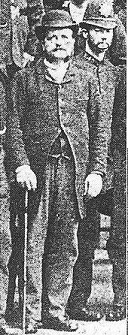
Martha Tabram was a 37-year old prostitute who was found dead on the morning of the 7th August 1888, just outside the White Hart. She had been stabbed 39 times. She had last been seen with a client who was a soldier, though he was never identified, and this was the initial avenue of investigation. By the end of September, though, the papers had re-labeled her as one of the first victims of Jack the Ripper. [2] As such, given her place of death and the fact that he fit the profile the police had decided on for the killer (possessing surgical skill and conveniently foreign), Severin was interviewed. He was soon discarded as a suspect, though Inspector Abberline (who headed the investigation) would later say that he had considered him almost certainly guilty. Why the Inspector might say that will become clear later.
In 1889 Severin got married to a Polish girl called Lucie Badewski. (Whether he had married the girl he left behind in Poland and this was bigamy is unclear, though given his later behaviour it seems unlikely.) The pair met in a social club for Polish emigres, and they only got married after Lucie found out that she was pregnant. By now Severin had his own barber-shop, and had stopped using the false name of “Ludwig” (possibly due to his investigation by the police). Their son died young though, as was sadly common at the time, and this may have been what prompted them to emigrate to America in 1891.
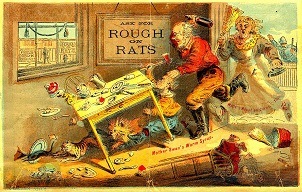
Severin got a job at a barber shop in New Jersey City, but he and Lucie soon fell out. They fought bitterly, mostly due to Severin’s cheating on her, and he was often observed by patrons to the shop beating her. This all culminated in a terrifying incident in 1892, when Severin attacked his (pregnant) wife, pinning her to their bed at the back of the shop. He was interrupted by someone coming in and so Lucie escaped, but she noticed that he had left a knife lying by the bed so she hid it. After the customer had left, Severin told her that they had saved her from having her head cut off and then being buried in the shop. She asked what the neighbours would have though, and Severin calmly replied:
Oh, I should simply have told them that you had gone back to New York.
Unsurprisingly Lucie (despite being six months pregnant) was soon on her way back to London on her own. She gave birth to a son there in May of 1892, and on hearing this Severin also returned to London. The two attempted a reconciliation for the sake of the child, but soon Lucie threw Severin out and the two separated (though as Catholics they could not divorce). This would probably be the best decision Lucie Klosowski ever made.
Severin may have briefly returned to America after this (his papers later indicated that he returned from America in 1893 with £1000, which would have been a great deal of money at the time). We definitely know that in late 1893 he was working in a barbershop in Tottenham. There he became involved with a woman named Annie Chapman. [4] He may have originally hired her as a housekeeper, but the two were soon sleeping together and even telling neighbours that they were married. The pair remained together until the end of 1894, when Severin’s open infidelity led Annie to leave him. She returned in January of 1895 when she realised she was pregnant, but Severin laughed and told her she’d get nothing from him. Annie even contacted a solicitor, but as the two were not married she (under the law of the time) had no rights. In February of 1895 Severin left Tottenham, and once again took a false name to avoid a scorned woman. In perhaps a calculated insult the name he chose was Chapman – George Chapman.
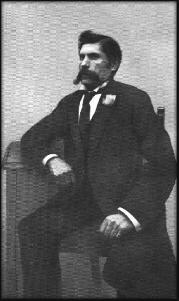
George moved to Leytonstone in east London where he became an assistant in a barber-shop again. He soon became acquainted with a local woman named Mary Spink. Mary was older than him, 39 to George’s 30, but she had a £500 inheritance from her grandfather that sparked his interest and he rented a room in the same house as her. After the two were caught kissing on the stairs by their landlady they then told her they had a Roman Catholic wedding – though this was a complete lie as both still had living former spouses. (Mary’s ex-husband was a railway porter who had retained custody of their eldest son while Mary had the youngest, a boy named Willy.) After their “marriage” the new Mr and Mrs Chapman left London, and moved to Hastings on the south coast. There they used £200 of Mary’s inheritance to buy themselves a barbershop in the town.
Business was slow at first, until the couple hit on the idea of combining their talents to attract custom. They installed a piano in the shop which Mary played for the customers. Soon their “musical shaves” became well known around Hastings and business was booming. George bought a boat, and took up photography and cycling. Mary didn’t flourish as well as her husband though – she had always been a functioning alcoholic but now she began to drink even more heavily and the two fought bitterly. Of course George was still also cheating on her, and had an affair with a servant named Alice Penfold. Eventually the Chapmans decided to leave Hastings, possibly due to a couple of mysterious bouts of illness that Mary suffered, and the rest of her inheritance was spent on buying a pub in Finsbury. In August of 1897 George and Mary returned to London.
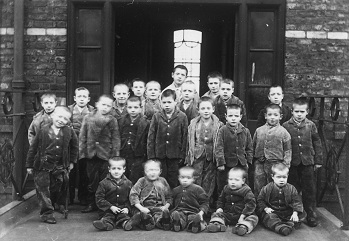
Mary’s health didn’t improve though, and took a major downturn in November. By December a woman named Martha who was a regular from the pub had begun staying over to care for her. In December she told George he’d better send for a doctor, who diagnosed her with tuberculosis. None of his medicines helped though, and her tuberculosis seemed of a peculiar variety. The main symptom was nausea, and she was incapable of keeping food down. George solicitously prepared brandies for her, but these only seemed to make her worse. On Christmas morning she had a violent attacked, and at 1pm she died. George didn’t seem to be too upset by Mary’s death, though to be fair it was hardly unexpected. Still, it did raise some eyebrows when he opened the pub that night as usual. A few days later Mary was buried, and a month later George took her son Willy down to one of Doctor Thomas Barnardo’s orphanages. They were reluctant to take him in since they felt George should care for him, so Willy was left with him until the following year when George sent him off to the workhouse. By then Willy’s mother had been replaced by a new woman in George’s life.
In fact, it was only a few months after Mary’s death that George hired Bessie Taylor to work in the pub. As always with the women he hired, George soon had persuaded her into his bed as well. As with Mary, the two told people that they were married, and Bessie’s family in the country even sent her £50 as a wedding present. The pair moved out to the country in August of 1898 (possibly with Willy still in tow). Later that year Bessie suffered severe dental problems and had to go into hospital around Christmas of 1898. A friend named Elizabeth Painter visited her around then and saw her and George arguing a lot. Bessie was doubtless in a lot of pain, while George was just argumentative by nature. Elizabeth did recall seeing George threaten Bessie with a revolver at least once.
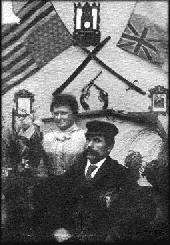
In early 1899 they sold their pub in the country and moved back to London, where Bessie’s health and temperament recovered. She was well known and well liked, and became involved in local charity work. Her parents came to visit, and they met and liked George. Things seemed to be going well for a while, and then in December of 1900 Bessie fell ill. She suffered from regular vomiting, and deteriorated quickly. Her brother visited, as did her friend Elizabeth. George was not so distressed by his “wife’s” condition that he missed the chance to make a pass at her. The doctor was called in, but he was unable to help. Hysteria and cancer were both considered, but neither seemed to be the case. Her mother came to care for her and for a while Bessie seemed to be improving, but on the night of the 12th of February she suffered a final sudden attack and died. Her brother William paid for the funeral, after George claimed he could not afford it.
A year and half later in August of 1901, George hired an 18 year old girl named Maud Marsh as a barmaid for his pub. Maud’s mother came with her to the interview and was dubious about the requirement that she live in the pub, but she was reassured by the fact that George was renting some of the upstairs rooms to other people so Maud would not be alone with him. Of course, by the time she moved in George had got rid of the other tenants. He immediately started trying to get her to sleep with him, but though Maud was attracted to him she insisted that they would have to get married first. By September they were engaged, though she still held out against George’s attentions. Her family were somewhat distressed by this, though George mollified them by showing he had £400 in the bank and had drafted a will leaving it all to Maud.
In October, while Maud’s younger sister was visiting, they left her in charge of the pub and went to the local Roman Catholic church. There either George bigamously married her, or he had somebody perform a sham marriage. Or else Maud was persuaded to go along with his pantomime when they returned to the pub and told her sister that they were married. However it was, it was done. Maud’s parents were upset, but she soon persuaded them of how happy she was married to George and eventually they accepted him into their family.
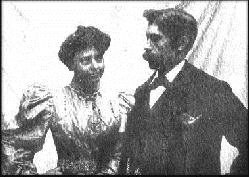
“Married” life was no bed of roses for the Chapmans, though. The first major calamity was an ill-judged attempt by George to burn his pub down for the insurance money near the end of his lease. He made some obvious mistakes, including moving his furniture out of the building – enough that the insurance company refused to pay out, though not enough that the police arrested him for arson. He was lucky enough to get the lease on a larger and more successful pub, near St Guy’s Hospital. Shortly after they moved there, Maud told him she was pregnant. George had no wish to raise another child though, so he pressured her into letting him carry out an illegal amateur abortion. George’s next adventure came when he fell victim to a pair of confidence tricksters who came into his pub and tried to sell him shares in a bankrupt gold mining company. George discovered the con and told the police, though he claimed (perhaps out of vindictiveness, or out of some hope that he would get some of their possessions) that he had paid them £700 and not the £7 he actually had.
In June of 1902, George’s eye began to rove once again. Maud had hired a woman named Florence Rayner to work in the pub, but once she found her and George in a compromising situation she fired Florence. She also threatened to leave George, but before she could do so she fell ill. This time the proximity to St Guy’s meant that her mother and sister were able to take her there, though George tried to prevent it as he claimed a distrust of hospitals. She spent four weeks in hospital, and had improved enough by the the 10th August to be sent home. In October though she had a relapse, and for the next few weeks she suffered intermittent attacks. Her sister and parents visited frequently, and noted that all her food was carefully prepared by George though this didn’t seem to help much. On the night of the 21st October Maud’s mother stayed by her bedside. George had left some brandy for Maud to try to settle her stomach, and Mrs Marsh also drank some of it. She started vomiting as well, and thought there might be something wrong with the brandy. Her suspicions came too late for her to take any action though, as the next day, with George and her mother by her bedside, Maud died.
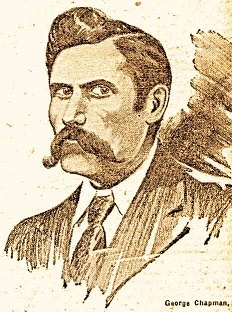
On the request of Maud’s parents, the doctor didn’t sign the death certificate and send Maud for a private post-mortem. The doctor performing the post mortem was looking for arsenic, and he found traces of it. It later turned out this was a mistake, but it was enough to get a police investigation into the death going. On the 25th October George Chapman was arrested for Maud’s murder. The police searched the premises and found George’s private papers (from which they learned his real name), and a quantity of cash that included several he had reported as being stolen by the con artists. [5] Meanwhile the coroner’s court investigating Maud’s death ordered a second post mortem, and this determined the real cause of death, a massive dose of antimony. This was a common chemical used in medicines at the time, mostly purges and laxatives. The quantity in Maud’s system was massive, though – enough to be definitely the cause of death.
Given the evidence, the coroner ordered the exhumation of Mary Spink and Bessie Taylor. In both cases the bodies of the dead women were found to be in an amazingly well preserved condition, and in both cases this was due to a massive amount of antimony in their systems which had resulted in the dehydration of their bodies. It became clear that all three of George’s dead partners had been systematically poisoned with antimony over a prolonged period of time. As a medically trained man, George would have been familiar with the effects of antimony overdose. In December of 1902 the coroner’s court determined that Maud Marsh had been wilfully murdered by by George Chapman, and on the 16th March the following year he was put on trial for that crime. The trial lasted for days, and it took the jury only ten minutes to convict him. He had done his best to dispose of the poison still in his possession, but the chemists who had sold it to him (in the form of the medicine “tartar emetic”) had kept records, and that was enough to prove possession. His real name of Severin Klosowski came out as part of the proceedings, and his wife Lucie thus tried several times to visit him in prison. He refused to see her, as he refused to admit that he was Severin Klosowski or that he was guilty of his crimes. He was executed on the 7th April 1903, still protesting his innocence to the end.
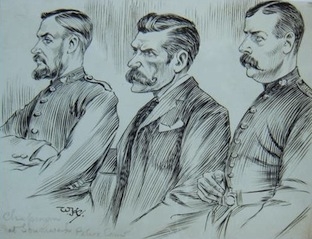
Ironically though, what made George Chapman, or rather Severin Klosowski, infamous was not the crime he committed but rather the crime he did not. On hearing that Severin had been arrested for murder, Inspector Abberline was reported to have congratulated the police department who had arrested him on having “got the Ripper at last”. Later that year Abberline gave two interviews to the Pall Mall Gazette where he gave his reasons for being sure that Severin was the Ripper – which, in addition to his surgical skill and proximity to the crimes, also included an interview with Lucie in 1888 where she said that her husband would “often go out during the night time”; and also a murder in New Jersey after Severin had moved there which had seemed somewhat Ripperesque. Scant evidence, but to Abberline the fact that Severin had turned out to be a killer was enough to prove the case. Was it, though? It would be highly unusual, after all, for a murderer to change from violent spree-killing to systematic poisoning. Though Abberline’s comments would ensure that Severin would always be linked to the Ripper killings, in the end does it really matter? He was a killer, and a coward, and thus forever beneath our contempt.
Images via wikimedia except where stated.
[1] Since both jobs involved wielding sharp blades they have traditionally often been combined.
[2] Nowadays it’s considered debatable whether she was a Ripper victim, as her death differed in several ways from the Ripper MO. On the other hand, it could be that she was killed while he was developing that MO. It’s also worth bearing in mind that some scholars even doubt that “Jack the Ripper” existed outside of media invention, as Victorian London was a dangerous and lawless city where sex workers in particular were at a great deal of risk. As such it may be the only thing that distinguishes the “Ripper’s victims” is that they died while the media was pretending to care about those murders.
[3] It’s possible that his Polish lover/first wife came over to London again to harass him, so he might have been fleeing a charge of bigamy.
[4] Coincidentally the same name as a Ripper victim, though she was no relation.
[5] This was enough to get the conman who had been convicted a full pardon.
